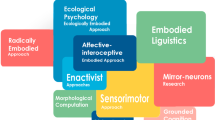Abstract
Conceptual structures are commonly likened to scientific theories, yet the content and motivation of the theory analogy are rarely discussed. Gregory Murphy and Douglas Medin's “The Role of Theories in Conceptual Coherence” is a notable exception and has become an authoritative exposition of the utility of the theory analogy. For Murphy and Medin, the theory analogy solves what they call the problem of conceptual coherence or the problem of conceptual glue. I argue that they conflate a number of issues under these rubrics and that in each case either the problem to be solved isn't subject to a general solution or the theory analogy is of little use. The issues I consider are: (1) what makes a concept efficient, useful, and informative, (2) what makes a concept refer to what it does, (3) what makes a set of objects form a single category, and (4) what makes concepts combine in one way rather than another.
Similar content being viewed by others
References
Carey, S. (1985), Conceptual Change in Childhood, Cambridge, MA: MIT Press.
Carey, S. (1991), ‘Knowledge Acquisition: Enrichment or Conceptual Change?’ In S. Carey and R. Gelman, eds. The Epigenesis ofMind: Essays on Biology and Cognition, Hillsdale, NJ: Lawrence Erlbaum Associates.
Cohen, B. and Murphy, G. (1984), ‘Models of Concepts’, Cognitive Science 8, pp. 27–58.
Fodor, J. and Lepore, E. (1992), Holism: A Shopper's Guide, Cambridge, MA: Blackwell.
Gopnik, A. and Meltzoff, A. N. (1997). Words, Thoughts, and Theories, Cambridge, MA: MIT Press.
Keil, F. (1989), Concepts, Kinds, and Cognitive Development, Cambridge, MA: MIT Press.
Kornblith, H. (1993), Inductive Inference and Its Natural Ground: An Essay in Naturalistic Epistemology, Cambridge, MA: MIT Press.
Kuhn, T. (1962), The Structure of Scientific Revolutions, Chicago: Chicago University Press.
Laurence, S. and Margolis, E. (in press), ‘Concepts and Cognitive Science’, In E. Margolis and S. Laurence, eds. Concepts: Core Readings, Cambridge, MA: MIT Press.
Lewis, D. (1970), ‘How to Define Theoretical Terms’, Journal of Philosophy 67, pp. 427–446.
Lewis, D. (1972), ‘Psychophysical and Theoretical Identifications’, Australasian Journal of Philosophy 50, pp. 249–258.
Margolis, E. (1995), ‘The Significance of the Theory Analogy in the Psychological Study of Concepts’, Mind & Language 10, pp. 45–71.
Medin, D. (1989), ‘Concepts and Conceptual Structure’, American Psychologist 44, pp. 1469–1481.
Medin, D. and Ortony, A. (1989), ‘Psychological Essentialism’, In S. Vosniadou and A. Ortony eds., Similarity and Analogical Reasoning. New York: Cambridge University Press.
Medin, D. and Wattenmaker, W. (1987), ‘Category Cohesiveness, Theories, and Cognitive Archeology’, In U. Neisser, ed. Concepts and Conceptual Development: Ecological and Intellectual Factors in Categorization, New York: Cambridge University Press.
Murphy, G. (1991), ‘Meaning and Concepts’, In P. Schwaneflugel, ed. The Psychology of Word Meanings, Hillsdale, NJ: Lawrence Erlbaum Associates.
Murphy, G. & Medin, D. (1985), ‘The Role of Theories in Conceptual Coherence’, Psychological Review 92, pp. 289–316.
Rey, G. (1983), ‘Concepts and stereotypes.’ Cognition, 15, pp. 237–262.
Rosch, E., Mervis, C. B., Gray, W. D., Johnson, D. M. and Boyes-Braem, P. (1976), ‘Basic Objects in Natural Categories’, Cognitive Psychology, 8, pp. 382–439.
Sellars, W. (1956), ‘Empiricism and the Philosophy of Mind.’ In H. Feigl and M. Scriven, eds. Minnesota Studies in the Philosophy of Science, I. Minneapolis: University of Minnesota Press.
Author information
Authors and Affiliations
Rights and permissions
About this article
Cite this article
Margolis, E. What Is Conceptual Glue?. Minds and Machines 9, 241–255 (1999). https://doi.org/10.1023/A:1008358032215
Issue Date:
DOI: https://doi.org/10.1023/A:1008358032215




